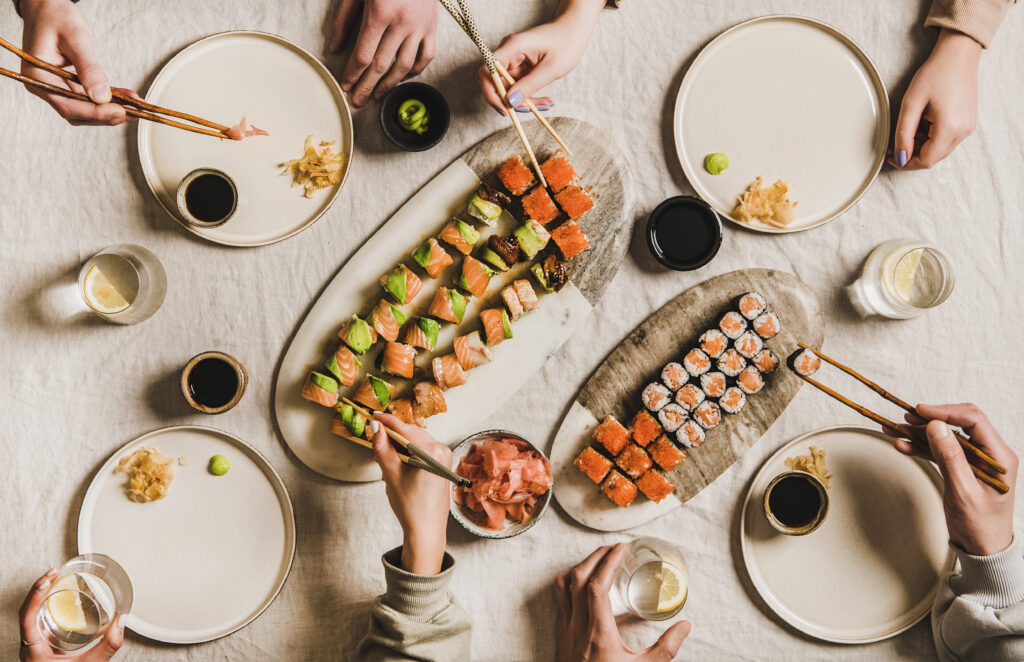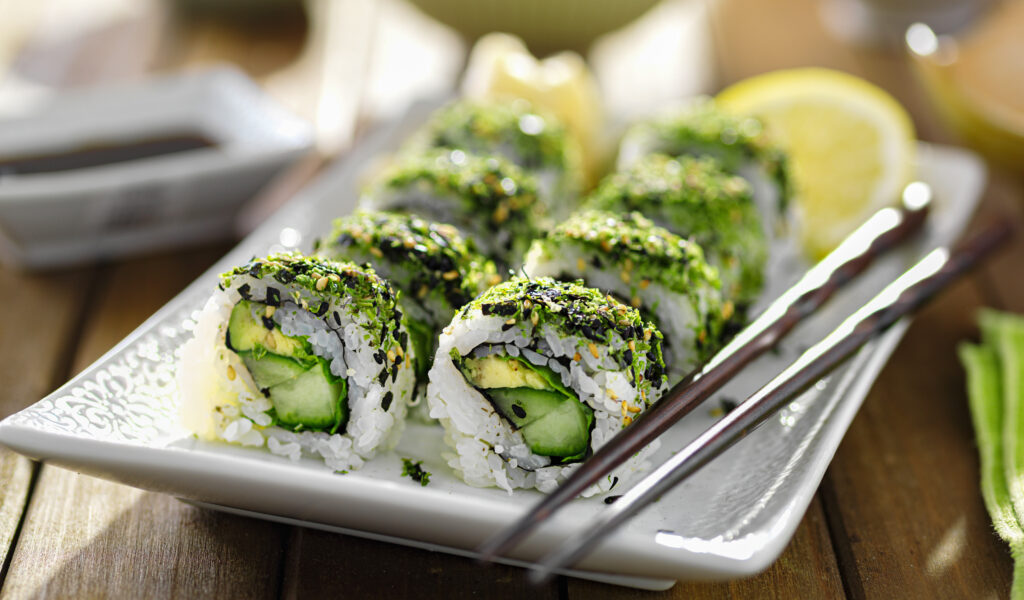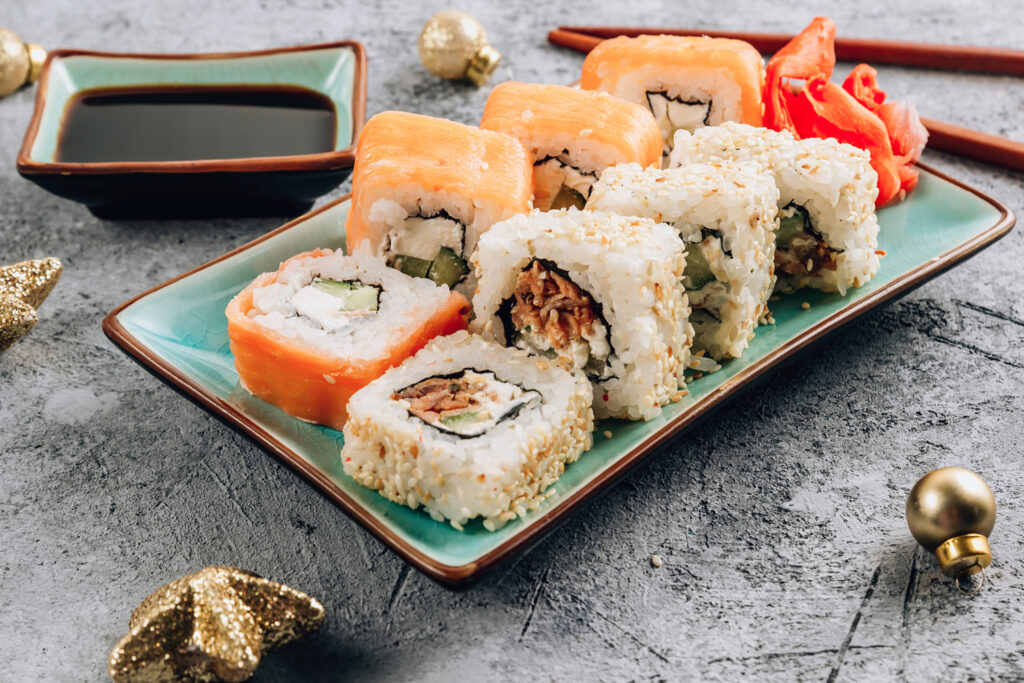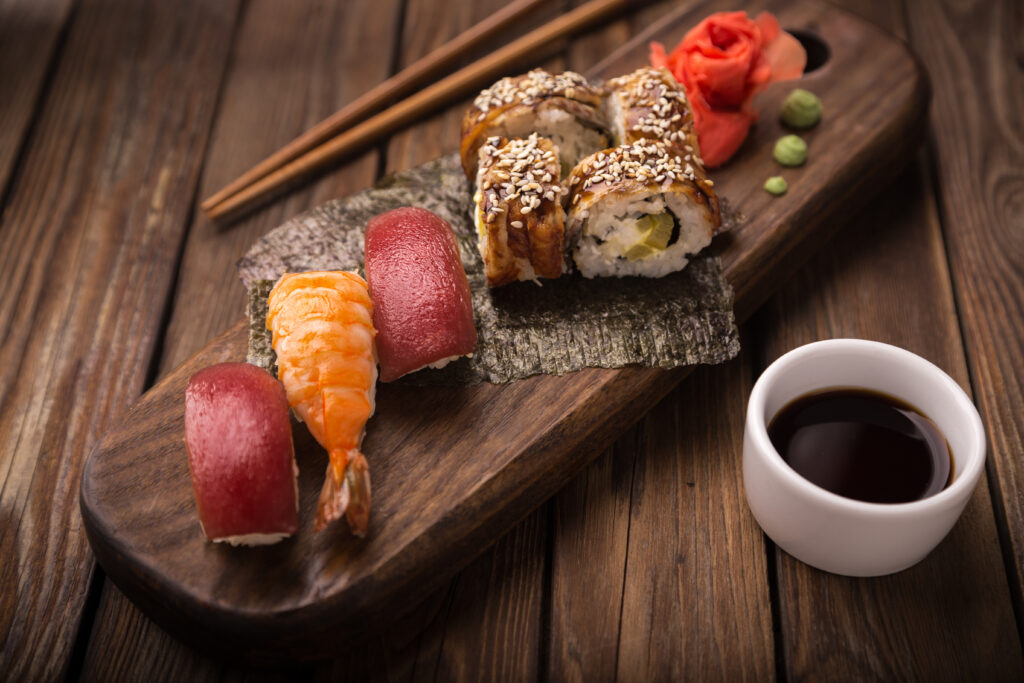Sushi is a delicious and nutritious way to get your fill of protein, vitamins, minerals, and omega-3 fatty acids. While the health benefits are plenty, it is important to remember that sushi can go bad quickly if not handled properly with food safety in mind. If you’re a sushi lover and ever wondered if leftover sushi is safe to eat and the signs to look for if it has gone bad, read on!

Table of Contents
What is Sushi?
Sushi is a traditional Japanese delicacy that typically consists of bite-sized pieces of raw fish served with small portions of cooked sticky vinegar rice. Sushi can also include other ingredients such as seaweed and fresh vegetables and it is often served with soy sauce, wasabi and pickled ginger.
There are many different types of sushi including Nigiri (small portions of fresh fish placed on top of oblong mounds of rice), Maki (sushi rolls with a nori sheet and rice), Temaki (hand-rolled cones of rice and other ingredients), and Sashimi (thin slices of raw fish without rice). Sushi is popular worldwide and is known for its delicate flavors, high-quality ingredients, fresh vegetables and gorgeous presentation.
Is leftover sushi safe to eat?
It depends. This is probably not what you wanted to hear but it is generally not recommended to eat leftover sushi the next day because the quality and safety of the ingredients may be compromised. Raw seafood, which is the main ingredient in sushi, is particularly susceptible to spoilage and can quickly become unsafe to eat.
Even when chilled bacteria and other microorganisms can grow rapidly, increasing the risk of food poisoning. If you do choose to eat leftover sushi the next day, it is important to store it properly and to carefully inspect the dish for signs of spoilage, such as an off odor, sliminess, or discoloration. We’ll discuss these signs later on in this post.
We think it’s always best to stay on the safe side and not eat sushi that is more than 24 hours old while others may say up to two days. Eating food that is past its prime can lead to serious health consequences, so it is important to always be mindful of the freshness of the food you consume.

How Long Does Sushi Last?
The shelf life of sushi depends on several factors, including the type of sushi, ingredients used, how it was stored, and the temperature at which it is kept. Sushi should be consumed as soon as possible after it is made.
If fresh sushi is stored properly in an airtight container in the refrigerator, it can last for up to 24 hours. As mentioned earlier, bacteria and other microorganisms can grow rapidly in the warm and moist conditions created by the rice and other ingredients.
It is also important to make sure that the sushi is stored at a safe temperature which is 40°F (4°C) or below. If the sushi has been stored at room temperature for more than two hours, it is best to discard it.
Note: For store-bought sushi be sure to check the expiration date and for homemade sushi take note of the use-by dates of your sushi ingredients.
How long does cooked sushi last?
Cooked sushi, such as futomaki rolls or inari sushi, can last longer than raw sushi as the cooking process can help to preserve the ingredients. However, it is still important to store the cooked sushi properly to reduce the risk of food spoilage and foodborne illness.
If stored properly in an airtight container in the refrigerator, cooked sushi can last for 3 to 4 days but to ensure the quality and safety of the cooked sushi, it is recommended to consume it within 24 to 48 hours.
As with raw sushi be sure to check for signs of spoilage, such as an off odor, discoloration, or changes in texture or taste, before consuming the cooked sushi. More on this later.

How long does leftover sushi rice last?
Leftover sushi rice can last for 3 to 5 days in the refrigerator if stored properly in a sealed container. Before storing the rice, let it cool completely to room temperature. Storing hot or warm food in the refrigerator can raise the temperature inside, leading to the growth of bacteria.
Can I just cook the sushi to extend it’s lifespan?
Absolutely! If you don’t plan on eating your sushi within a couple of days, you can try reheating it in the microwave or on the stovetop. However, you should be aware that reheating sushi may affect its flavor and texture.
The Dangers of Eating Expired Sushi
The dangers of eating bad sushi include the risk of food poisoning and other illnesses. When sushi is kept too long or is not stored at the proper temperature the dish may become unsafe to eat.
Some of the common illnesses associated with eating expired or improperly stored sushi include food poisoning caused by bacteria such as salmonella, listeria and e. coli. These bacteria can cause symptoms such as nausea, vomiting, diarrhea, fever, and stomach cramps. Not fun!
How do you store leftover sushi?
Place the sushi in an airtight container or wrap it tightly in plastic wrap. Make sure the temperature in the refrigerator is at or below 40°F (4°C). Label the container with the date AND time the sushi was made so you can keep track of its freshness.
Can you freeze sushi leftovers?
Yes, you can freeze leftover sushi, but please don’t! While freezing can help to extend the shelf life of sushi, it can also cause changes in texture and flavor, and may not be suitable for all types of sushi.
When freezing sushi, wrap it tightly with plastic wrap to prevent freezer burn. You can also place the sushi in an airtight container or freezer bag to further protect it. Make sure to label the sushi with the date it was frozen.
To defrost frozen sushi, transfer it to the refrigerator and let it thaw slowly over several hours. Do not thaw sushi at room temperature, as this can cause bacteria to grow rapidly. Before consuming, be sure to inspect it for spoilage. But again, please don’t freeze your sushi!

What are the signs of spoiled sushi?
The signs of spoilage in sushi can vary depending on the ingredients and how it was stored, but some common indicators include:
- Strange odor: If the sushi has a strong fishy smell or odd odor, this is the first sign that it has gone bad.
- Discoloration: If the sushi has changed color, such as the fish turning gray or brown, it’s best to throw it out.
- Slimy or sticky texture: If the fish or other ingredients in the sushi have a slimy or sticky texture, this may indicate the growth of bacteria or other microorganisms, making the sushi unsafe to eat.
- Changes in taste: If the sushi has a noticeable change in taste, such as a sour or bitter flavor, it is definitely spoiled.
- Mold growth: If there is visible mold growing on the sushi, it is no longer safe to eat and should be discarded.
It doesn’t take much effort in order to ensure that your sushi stays safe for consumption; simply following these guidelines should do the trick! However, if you’re ever unsure about whether or not your meal has gone bad you should discard it – better safe than sorry! Don’t let expired sushi ruin your day – follow these tips and enjoy these healthy, tasty treats.












11 Responses
Thank you for addressing this common concern about leftover sushi. Your tips for storing leftover sushi safely are very helpful. I’ll definitely keep them in mind.
What a wonderful and comprehensive guide on how to safely eat sushi. Will keep all these points in mind if I ever have leftovers (no likely, lol).
Very informative for all Sushi Lovers and I am one of them. Thanks….
This is such a great article! My partner and I love to get sushi but we’re inevitably unable to finish all of it most of the time. We’ll definitely be referring back to this!
So much useful info! I always wonder about this and usually throw out my sushi earlier than necessary since I don’t add any raw fish. Glad I came across your article.
A lot of good info here especially on how safely store the leftover sushi.
Thank you so much for sharing this with us!
Oh my, Sushi is one of my favorite Japanese delicacies! They have so much variety and they are absolutely delicious and very enticing! Such a great article to read especially for us who really loves sushi! As for me, Sushi is life!
We almost never have leftover sushi as it disappears almost as soon as I serve it!! However, this was such a useful article and I will bookmark it for future reference!
This is a great resource..I sometimes keep my homemade sushi more than 24 hours but likely won’t anymore.
Well, at least I know now that I have been storing my sushi all wrong and for too long! Thanks for the go-to guide on storing sushi from now on!
So many great tips in this post about the best practices when it comes to leftover sushi. I usually try to finish it the same day or the say after, but it’s still nice to know what to look for!